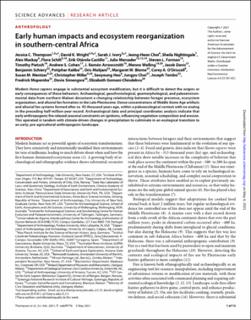| dc.contributor.author | Thompson, Jessica | |
| dc.contributor.author | Wright, David K. | |
| dc.contributor.author | Ivory, Sarah J | |
| dc.contributor.author | Choi, Jeong-Heon | |
| dc.contributor.author | Nightingale, Sheila | |
| dc.contributor.author | Mackay, Alex | |
| dc.contributor.author | Schilt, Flora | |
| dc.contributor.author | Otarola-Castillo, Erik | |
| dc.contributor.author | Mercader, Julio | |
| dc.contributor.author | Forman, Steven L. | |
| dc.contributor.author | Pietsch, Timothy | |
| dc.contributor.author | Cohen, Andrew S. | |
| dc.contributor.author | Arrowsmith, J. Ramon | |
| dc.contributor.author | Welling, Menno | |
| dc.contributor.author | Davis, Jacob | |
| dc.contributor.author | Schiery, Benjamin | |
| dc.contributor.author | Kaliba, Potiphar | |
| dc.contributor.author | Malijani, Oris | |
| dc.contributor.author | Blome, Margaret W. | |
| dc.contributor.author | O'Driscoll, Corey A. | |
| dc.contributor.author | Mentzer, Susan M. | |
| dc.contributor.author | Miller, Christopher E. | |
| dc.contributor.author | Heo, Seoyoung | |
| dc.contributor.author | Choi, Jungyu | |
| dc.contributor.author | Tembo, Joseph | |
| dc.contributor.author | Mapemba, Fredrick | |
| dc.contributor.author | Simengwa, Davie | |
| dc.contributor.author | Gomani-Chindebvu, Elizabeth | |
| dc.date.accessioned | 2021-05-12T07:29:31Z | |
| dc.date.available | 2021-05-12T07:29:31Z | |
| dc.date.created | 2021-05-06T14:15:54Z | |
| dc.date.issued | 2021-05-05 | |
| dc.identifier.issn | 2375-2548 | |
| dc.identifier.uri | https://hdl.handle.net/11250/2755074 | |
| dc.description.abstract | Modern Homo sapiens engage in substantial ecosystem modification, but it is difficult to detect the origins or early consequences of these behaviors. Archaeological, geochronological, geomorphological, and paleoenvironmental data from northern Malawi document a changing relationship between forager presence, ecosystem organization, and alluvial fan formation in the Late Pleistocene. Dense concentrations of Middle Stone Age artifacts and alluvial fan systems formed after ca. 92 thousand years ago, within a paleoecological context with no analog in the preceding half-million-year record. Archaeological data and principal coordinates analysis indicate that early anthropogenic fire relaxed seasonal constraints on ignitions, influencing vegetation composition and erosion. This operated in tandem with climate-driven changes in precipitation to culminate in an ecological transition to an early, pre-agricultural anthropogenic landscape. | en_US |
| dc.language.iso | eng | en_US |
| dc.publisher | American Association for the Advancement of Science | en_US |
| dc.rights | Navngivelse-Ikkekommersiell 4.0 Internasjonal | * |
| dc.rights.uri | http://creativecommons.org/licenses/by-nc/4.0/deed.no | * |
| dc.title | Early human impacts and ecosystem reorganization in southern-central Africa | en_US |
| dc.type | Journal article | en_US |
| dc.type | Peer reviewed | en_US |
| dc.description.version | publishedVersion | en_US |
| dc.rights.holder | © 2021 The Authors, some rights reserved; exclusive licensee American Association for the Advancement of Science. | en_US |
| dc.source.articlenumber | eabf9776 | en_US |
| cristin.ispublished | true | |
| cristin.fulltext | original | |
| cristin.qualitycode | 1 | |
| dc.identifier.doi | 10.1126/sciadv.abf9776 | |
| dc.identifier.cristin | 1908561 | |
| dc.source.journal | Science Advances | en_US |
| dc.identifier.citation | Science Advances. 2021, 7 (19), eabf9776. | en_US |
| dc.source.volume | 7 | en_US |
| dc.source.issue | 19 | en_US |

